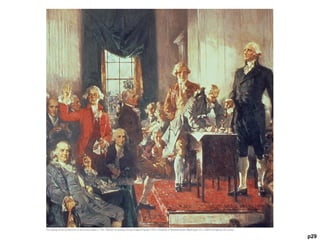
Images2
Notes de l'éditeur
- This famous painting of the signing of the Constitution on September 17, 1787, was commissioned by Congress and completed by Howard Chandler Christy in 1940. It is a 20 3 30-foot oil on canvas and hangs in the U.S. Capitol. (Only part of the painting is shown here.)
- General George Washington and the Marquis de Lafayette visit suffering soldiers in the encampment of the Continental Army at Valley Forge, Pennsylvania, during the winter of 1777–1778. Congress’s inability to provision the army with adequate food and clothing undermined the war effort.
- On January 25, 1787, Daniel Shays and his rebels attacked the armory at Springfield, Massachusetts, which was successfully defended by local militia. This violent effort to undermine lawful authority prepared the public mind for a stronger national government.
- FIGURE 2-1 The United States was the first constitutional democracy. In most of the world at the time, the people had little say in how they were governed.
- The Assembly Room of the Pennsylvania State House, later renamed Independence Hall, is where the Second Continental Congress debated and approved the Declaration of Independence in July 1776, and where the Constitutional Convention fashioned the Constitution in the summer of 1787.
- Sometimes called the “Father of the Constitution,” James Madison of Virginia is more responsible than any other single person for replacing the defective Articles of Confederation with a more powerful and effective national government. His efforts were vital to the calling of the Convention, to the drafting of the Constitution at Philadelphia, to the success of the ratification contest, and to the addition of a sound Bill of Rights.
- Alexander Hamilton, a brilliant 32-year-old lawyer and former aide to General Washington in the Revolutionary War, gave a famous speech at the Constitutional Convention on June 18 calling for a central government even stronger than that proposed in the Virginia Plan. Later, he worked tirelessly to secure ratification by New York by writing most of the Federalist essays and leading the pro-Constitution forces in the state ratifying convention.
- James Wilson of Pennsylvania, an eminent expert on law, was a signer of the Declaration of Independence, highly influential member of the Constitutional Convention (perhaps second only to Madison in importance), and one of the six original members of the U.S. Supreme Court. He became the nation’s second professor of law at an academic institution.
- Although not well known to modern Americans, Gouverneur Morris of New York and Pennsylvania was one of the most influential members of the Constitutional Convention. He gave the most speeches, was a vigorous proponent of a strong national executive power, and as a member of the Committee of Style was responsible for giving the final form and polish to the Constitution. He is credited with drafting the Constitution’s now famous Preamble.
- The British House of Commons wields the effective lawmaking power in the British Parliament, with the House of Lords limited to advising and proposing amendments to legislation. In the House of Commons, the opposition parties sit facing each other, with their leaders in the front row. Nonleaders are called “backbenchers.”
- This is the chair in which George Washington sat while presiding over the Constitutional Convention.
- This is how the famous Federalist 10 essay appeared in the New York Daily Advertiser on November 22, 1787.
- FIGURE 2-2 Of the four possible ways to amend the Constitution, two have never been used, and another has been used only once. Under the Constitution, Congress decides on the method of ratification.
- This newspaper advertisement for newly arrived slaves from Africa appeared in the South Carolina Gazette in the 1740s.